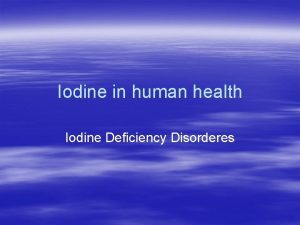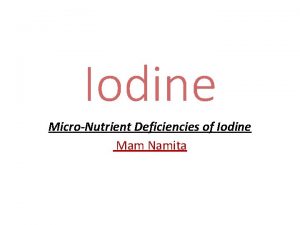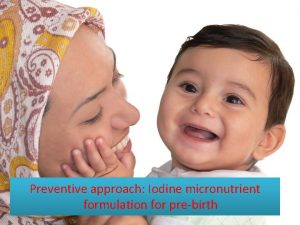IODINE NUTRITION MONITORING IN SCHOOLCHILDREN AND PREGNANT WOMEN









- Slides: 9

IODINE NUTRITION MONITORING IN SCHOOLCHILDREN AND PREGNANT WOMEN IN BELARUS: PRELIMINARY DATA OF NATIONAL SURVEY 2017 -2018 Sergei V. Petrenko MD, Ph. D Head of Laboratory of Anthropoecology and Public Health, Associate Professor International Sakharov Environmental Institute of Belorussian State University Minsk, Belarus Strengthening Monitoring System in Countries of South-Eastern Europe and Central Asia Tbilisi, Georgia February 20, 2017


IODINE NUTRITION IN BELARUS: HISTORIC VIEW First National Survey (1997 -1999) showed: 1. Median of urinary iodine excretion in children was 44, 5 µg/L 2. More than 80 per cent of population settles in regions with middle and severe iodine deficiency 3. Iodinated salt was used by less than 30 per cent of population 4. Only 14 per cent of population were provided with iodinated salt produced in Belarus 5. Goiter rate reached 30 - 35 per cent among population

MAIN FEATURES OF BELARUS MODEL OF IODINE ELIMINATION Governmental strategy of IDD elimination developed in 1999 -2004 based on the large scale and comprehensive using of iodized salt 1. Establish a legal and regulatory framework 2. Improve the quality and increase the production of iodized salt 3. Ensure that the food processing and bread making industry relied only on iodized salt 4. Using only iodized salt in school children and kindergarten meals 5. Balanced nutrition of population by trace elements including iodine is a necessary requirement of Belorussian Legislation “On Quality and Safety of Food Raw Materials and Food Products for Human Health and Life” 6. Provide the hygiene and medical monitoring of iodine supplementation of population to ensure the efficiency of fulfillment of this strategy

RESULTS OF BELORUSSIAN MODEL IMPLEMENTATION: URINARY IODINE EXCRETION IN CHILDREN urinary iodine excretion 250 193 200 180, 6 177, 6 170 150 128, 6 urinary iodine excretion 100 67, 6 50 0 2001 2003 2007 2011 2013 2017

IODINE NUTRITION OF CHILDREN FROM DIFFERENT REGIONS OF BELARUS 2017 -2018 N Region Median (ug/L) 1. Brest 137, 1 2. Grodno 178, 0 3. Gomel 133, 1 4. Mogilev 261. 4 5. Minsk 169, 1 6. Vitebsk 204, 8 7. Belarus 180, 6

IODINE NUTRITION OF PREGNANT WOMEN FROM DIFFERENT REGIONS OF BELARUS 20172018 N Region Median (ug/L) 1. Brest 159, 7 2. Grodno 129, 8 3. Gomel 110, 8 4. Mogilev 121, 1 5. Minsk 6. Vitebsk 125, 3 7. Belarus 129, 3

CONCLUSIONS 1. Belarusian Model of iodine deficiency elimination based on obligatory using the iodized salt in food and bakery producing had showed its efficiency for elimination of iodine deficiency in children. 2. Evidently, that for pregnant women it is necessary to improve their iodine nutrition by additional use of iodine containing medicines. 3. To improve the iodine status of pregnant women it is necessary to investigate more thoroughly the iodine sources in their nutrition.

ACKNOWLEDGMENT � 1. To the United Nations’ Children Found (UNICEF) Belarus; 2. To the Iodine Global Network 3. To Ministry of Education of Belarus
 Pregnancy prayer points
Pregnancy prayer points Vitagen yogurt drink
Vitagen yogurt drink 5 days of sample menus for pregnant women
5 days of sample menus for pregnant women Nutrition monitoring definition
Nutrition monitoring definition What is tender breast in pregnancy
What is tender breast in pregnancy Cesium telluride formula
Cesium telluride formula Iodine and sodium thiosulfate
Iodine and sodium thiosulfate Tincture of orange is prepared by which process
Tincture of orange is prepared by which process Potato and iodine diffusion experiment
Potato and iodine diffusion experiment Halogen triad
Halogen triad

















